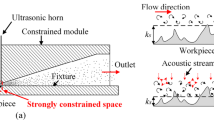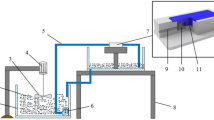Abstract
In this paper, a detailed simulation about ultrasonic-assisted polishing was conducted, which is helpful to understand the contribution of the ultrasonic vibration to polishing. The influence of ultrasonic vibration on flow field parameters and optimal ultrasonic parameters was investigated. Results indicate that ultrasonic vibration can produce a cavitation phenomenon, which can contribute to improving the polishing quality and material removal rate (MRR). Optimal ultrasonic frequency, amplitude and film thickness were 42 μm, 25 kHz and 14 mm, respectively. Furthermore, the required minimum film thickness was 1.5 mm, at which cavitation could occur normally. At last, contrast experiment indicated that polishing quality and MRR were much improved when using ultrasonic-assisted polishing. After polishing, there were only a few scratches and MRR was 0.68 μm/h compared with many scratches and 0.32 μm/h MRR of traditional polishing.















Similar content being viewed by others
References
Chen A, Wang Y, Qin J et al (2015) Chemical mechanical polishing for SiO2 film using polystyrene@ceria (PS@CeO2) core-shell nanocomposites. J Inorg Organomet Polym Mater 25(6):1407–1413
Chen Y, Long R (2011) Polishing behavior of PS/CeO2, hybrid microspheres with controlled shell thickness on silicon dioxide CMP. Appl Surf Sci 257(20):8679–8685
Chen Y, Li Z, Miao N (2014) Synergetic effect of organic cores and inorganic shells for core/shell structured composite abrasives for chemical mechanical planarization. Appl Surf Sci 314(24):180–187
Kubota A, Yoshimura M, Fukuyama S et al (2012) Planarization of C-face 4H-SiC substrate using Fe particles and hydrogen peroxide solution. Precis Eng 36(1):137–140
Zhou Y, Pan GS, Shi XL et al (2014) Chemical mechanical planarization (CMP) of on-axis Si-face SiC wafer using catalyst nanoparticles in slurry. Surf Coat Technol 251(1):48–55
Wang L, Yan QS, Lu JB et al (2014) Comparison of Fe catalyst species in chemical mechanical polishing based on fenton reaction for SiC wafer. Adv Mater Res 1027:171–176
Xu W, Lu X, Pan G et al (2010) Ultrasonic flexural vibration assisted chemical mechanical polishing for sapphire substrate. Appl Surf Sci 256(12):3936–3940
Tsai MY, Yang WZ (2012) Combined ultrasonic vibration and chemical mechanical polishing of copper substrates. Int J Mach Tools Manuf 53(1):69–76
Tso PL, Chang YC (2010) Study on chemical mechanical polishing with ultrasonic vibration. Adv Mater Res 126–128:311–315
Han G, Zhao J, Wang X (2017) Research on unbounded abrasive polishing process with assisted ultrasonic vibration of workpiece. Int J Adv Manuf Technol 88(1–4):209–218
Liu Y, Li SJ, Li Y et al (2012) Process parameters modeling and optimizing for compound machining with ultrasonic vibration on SiC wafer. Appl Mech Mater 217–219:6
Sun B, Zhang HC (2009) Numerical simulation of ultrasonic cavitation based on FLUENT. Lubr Eng 34(04):55–60
Wang GG, Sun DB, Zhang XL et al (2007) Dynamic impact behavior during bubble collapsing. J Univ Sci Technol Beijing 29(05):483–485
Slimane M, Oualid H, Yacine R et al (2014) Modeling of ultrasonic cavitation as an advanced technique for water treatment. Desalination Water Treat 56(6):1–11
Wu YB, Wang LJ (2014) A fundamental investigation on ultrasonic assisted fixed abrasive CMP (UF-CMP) of silicon wafer. Adv Mater Res 983:208–213
Skoczypiec S, Ruszaj A (2007) Application of ultrasonic vibration to improve technological factors in electrochemical machining of titanium alloys. In: Scripts precision and microproduction engineering, pp 143–148
Cui XX, Li M, Li DQ (2014) Study on eliminating disfigurement of small-deep holes of the ring laser gyro by grinding with ultrasonic vibration and polishing. Aeronaut Sci Technol 25(02):73–78
Skoczypiec S (2011) Research on ultrasonically assisted electrochemical machining process. Int J Adv Manuf Technol 52:565–574
Sajjadi B, Raman AAA, Ibrahim S (2015) Influence of ultrasound power on acoustic streaming and micro-bubbles formations in a low frequency sono-reactor: mathematical and 3D computational simulation. Ultrason Sonochem 24:193–203
Guo J, Morita SY, Hara M et al (2012) Ultra-precision finishing of micro-aspheric mold using a magnetostrictive vibrating polisher. CIRP Ann Manuf Technol 61(1):371–374
Acknowledgements
This work is financially supported by the National Natural Science Foundation of China (Project No. 51475119).
Author information
Authors and Affiliations
Corresponding author
Rights and permissions
About this article
Cite this article
Zhai, W., Gao, B., Chang, J. et al. Optimization of Ultrasonic-Assisted Polishing SiC Through CFD Simulation. Nanomanuf Metrol 2, 36–44 (2019). https://doi.org/10.1007/s41871-018-0033-8
Received:
Revised:
Accepted:
Published:
Issue Date:
DOI: https://doi.org/10.1007/s41871-018-0033-8




